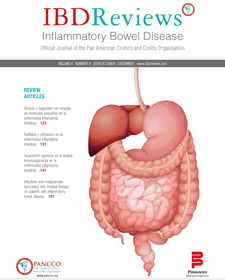Dermatological manifestations associated to the use of anti-tumor necrosis factor therapy
Contenido principal del artículo
Resumen
Anti-tumor necrosis factor (anti-TNF) drugs such as infliximab, adalimumab, and certolizumab pegol have been largely used for the treatment of inflammatory bowel diseases (IBD) for the past two decades. These biological agents showed efficacy and good safety profile in Crohn’s disease patients as well as in ulcerative colitis. The anti-TNF drugs have demonstrated good results not only just in the induction of remission but also in the long-term maintenance. Nevertheless, the occurrence of autoimmune processes related to anti-TNF agents is not rare. In this group, cutaneous inflammatory manifestations have increasingly been reported, most frequently describing the occurrence of psoriasis and psoriasiform eruptions presenting as a paradoxical reaction. Besides, a wide spectrum of inflammatory dermatological conditions has been associated to the use of anti-TNF drugs, such as vasculitis, lichenoid and acneiform eruptions, sarcoidosis, multiform erythema, toxic epidermal necrolysis, atopic dermatitis exacerbation, and alopecia. The precise explanation for this phenomenon remains unknown, but different explanations have been postulated. We made a retrospective study to understand when and how these skin lesions occur. It’s important to point out that in the vast majority of cases, skin lesions are mild and suspension or switching of treatment is unnecessary.

